#univex
Explore tagged Tumblr posts
Text
Mercury In Retrograde
One of my Favorite film cameras is the Mercury II. It's a half-frame camera from the 40's that was supposed to be the American rival to Contaxes and Leicas since we were having... second thoughts about doing business with Germany, and even Japan. Even though I'd adapted this lens to my Fuji X-E2 before, I'd never thrown it on my Sony A7ii.
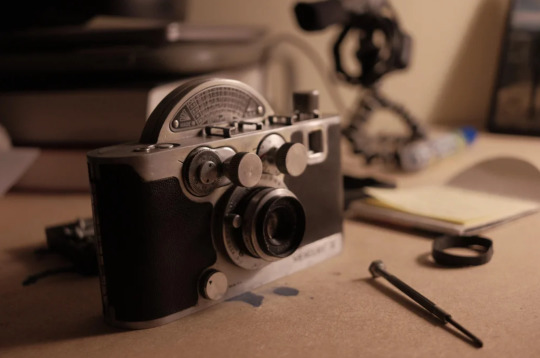
Here are some shots!


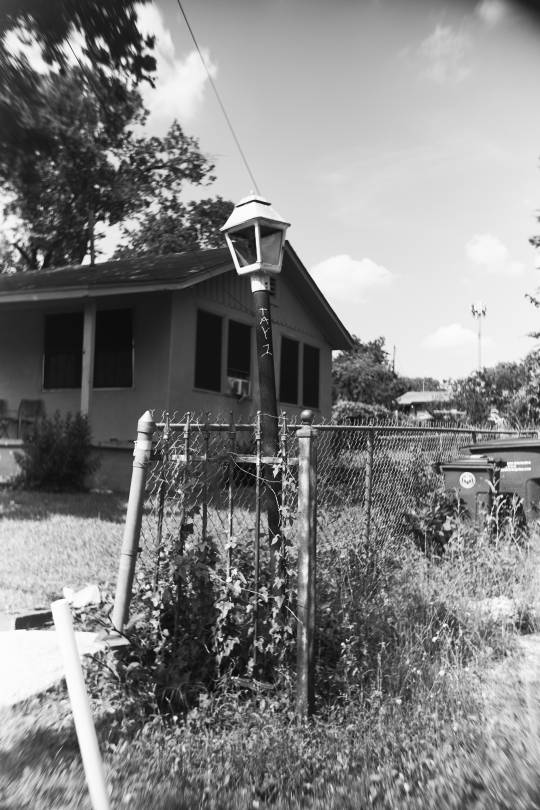

I figured I'd be able to use the APS-C mode in the menu, which just punches into the sensor, since half-frame is about the same size as APS-C anyway.




Overall, I'm pretty astonished by this lens' performance. It handles color and contrast well, and definitely has a vintage focus fall-off in the corners, which is common for three-element lenses like this one. The Bokeh looks good, and sharpness are on point!


So not bad for APS-C crop, right?
I've been withholding something. These are all shot full frame. Turns out this tiny lens covers the sensor at wider apertures with just a vignette. Stopped down, the corners fall out. Here's f/2.7 compared to f/8.


Not bad for a lens the size of a quarter!
2 notes
·
View notes
Text
Shop Online Univex Mixer parts - PartsFe

Univex mixer parts improves the efficiency of the product and helps to give the product a long life. Buy these parts from the PartsFe which provides genuine OEM parts with a warranty. Univex mixers are renowned for their performance and reliability in commercial foodservice operationfs. If you are looking for replacement parts for your Univex mixer, there is a wide range of genuine Univex mixer parts available to ensure the continued functionality and efficiency of your equipment.
0 notes
Text

Bronica ETRS with Zenzanon 50mm f2.8 lens, shot on Ilford HP5 pushed 4 stops to ISO 6400 and developed with Rodinal
Pictured: Univex Mercury II
#photography#film photography#ishootfilm#analog photography#filmisnotdead#b&w photography#vintage cameras#bronica etrs#etrs#120 film#medium format#ilford hp5#rodinal#still life photography#still life#indoor photography
15 notes
·
View notes
Text
"You probably know that I have a darkroom in the basement, which is where I get high on the fumes of something called Blix, a combination of bleach and fixer. I take pictures, I develop them and I scan the negatives and mess around with the images in Photoshop.
As you correctly assume I don't really want to make them public, partly because they would wither and crumble under scrutiny, but also it would make me self-conscious about doing it and I very much enjoy the luxury of this particular privacy.
I do like to show off my collection of oddball old-timey cameras to anyone who comes over, but I can detect something in my friends' polite smiles that tells me nobody else finds them as compelling as I do. The magnificent Univex Mercury with its one-of-a-kind rotating shutter!"
john linnell interview for "the rumpus", 2013
9 notes
·
View notes
Text
The Graflex Graphic 35 is a 35mm rangefinder.
The Graflex Graphic 35 is a 35mm rangefinder introduced in 1955 by Graflex as a replacement for the Graflex Ciro 35, the camera on which it was also heavily based. The Graphic 35 was designed in the US and earlier examples were made in Rochester although production shifted to Japan with Kowa later on. The lens and shutter were sourced from West Germany. The Graflex in 1959, 35mm film cameras began to take a larger portion of the market in the mid-1950s, and you are seeking a way to distinguish your cameras from the rest. The transistor radio only recently hit the market, and such electronic advances are not yet appearing in camera design. Especially with older camera companies who hired primarily mechanical engineers. Except for a few outliers such as the Miranda the interchangeable lens SLR is not yet a standard. Most manufacturers concentrated on fixed lens rangefinders during the 1950s. Canon and Nikon have only just unveiled their, yet successful, lines of SLR 35mm film cameras in 1959. In addition to this excellent balance of usability and capability, the Graphic 35 was one of the best values in photography at the time of its release. Costing just $77 for the version equipped with the 50mm F/3.5 lens and $98 for the faster F/2.8 lens, it was one of the most affordable full-featured 35mm film rangefinder-focusing cameras in production at that time.
The result of the camera’s combination of respectable performance, eye-catching new features and reasonable price was as we’d expect; it was popular. In just three years of production, the Graphic 35 sold approximately 68,000 units. I still used my Graphic 35 in 2024; that’s 70 years after someone in Rochester tightened the final screw and packed it in a box to be shipped to a camera shop. Cameras have come a long way in those 70 years, and yet the Graphic 35 remains a lot of great things, things that we still value in a camera today. It’s compact. It’s dense. It’s beautiful. It’s well-made and works like magic. Its knobs and dials and switches and levers actuate with precision, emitting the whirrs and clicks and the wicks that mechanical-thing-likers live for. In an earlier article, I called the Zeiss Contina a “clockwork camera” (a term that other bloggers and YouTubers have adopted despite a conspicuous absence of royalty checks). The Graphic 35 is similarly clock-like. I bought this Graphic 35 at the estate sale of Kirk Kekatos (founding member and former president of the Chicago Photographic Collectors Society) along with other cameras like the LaBelle Pal, Univex Model AF-4, Ansco Memo, Vest Pocket Kodak, and Bell & Howell Electric Eye 127. I had actually been looking for this camera’s successor—the Graphic 35 Jet—but couldn’t pass up a great deal on the Graphic 35 when I found one at the estate sale. And at the end of the someone came up to me with the Graphic 35 jet the person that bided for in the sale his cheque did not cleaner.
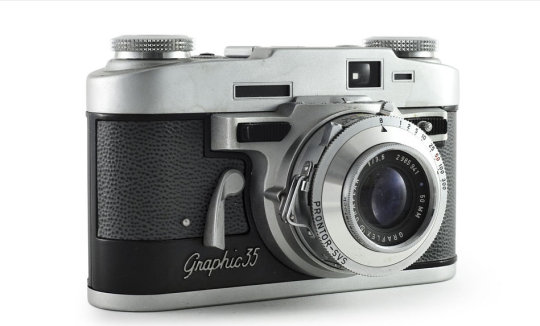
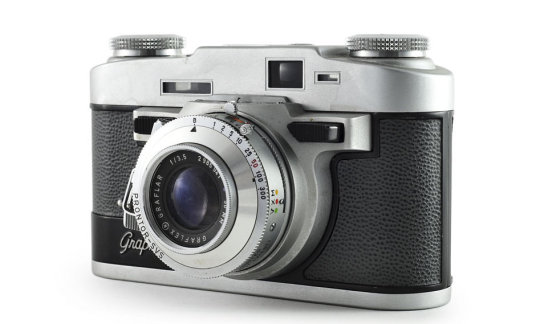
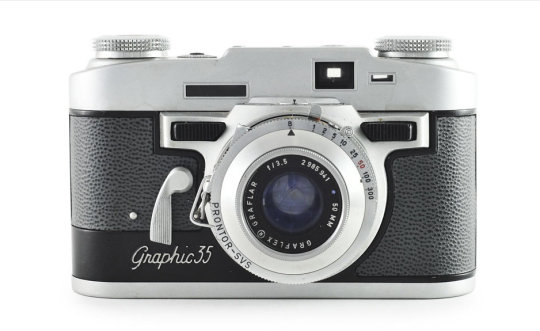
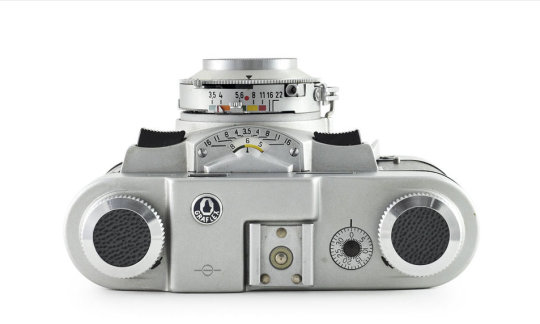


0 notes
Text
Dan 35 I Camera
I need to start this post back in time. I first started collecting cameras and other photo items in the late 1970s or early 1980s. I can remember purchasing one of McKeown's Camera Price Guides and spending hours combing through each camera manufacturer, looking at the cameras they had made in the past. There were so many odd and unusual like very rare original Leica; the very first bullet-shaped brass Voigtlander camera, the Compass camera or Photosphere that I could only dream of owning, and many were so far from the price budget that I knew there were only a pipedream.
Many large companies, like Eastman Kodak, Polaroid, and Zeiss, made hundreds of different model cameras, which were abundant. Then, there were the smaller camera companies that produced unique cameras, like Univex, which was the first camera I owned. It was a Uniflex that was given to me by my uncle Bud, who, to this day, along with my brother Tim, I owe my love of photography.
Then, I can remember thumbing through the price guide and finding a tiny company that produced a camera near and dear to me, the Dan camera. I immediately thought I needed to find one of these to put into my collection. My initial search was hopeless, as many of the local flea markets and antique stores I'd frequent only had the very common Kodak, Polaroid, Zeiss, and other companies like Herbert George and other American brands.
Online Auctions:
It would help to remember that this was before eBay, which didn't exist before the mid-1990s. I was an early adopter of buying and selling on eBay in 1997. At that time, there were no photos, and it was mainly just a buy/sell board with an auction element so you could post a camera or item for sale, but you only had the description from the seller to go by. When I first joined eBay, there was no name to have but a number. My original number was 1034; you had to do everything through DOS.
EBay made a massive difference as it gained popularity. It changed how people bought and sold items. Adding photos gave the buyer more confidence in their purchase, and rarer items could hit higher pricing due to the inability to find them.
For many years, the Dan Camera was very elusive, and since the camera was from a smaller company, the scarcity and pricing made the purchase of it next to impossible up until a couple of years ago when I was looking through a different online auction website, and I found a grouping of cameras which piqued my interest. As I zoomed in to look at this lot, there was a portion of a lens I could see. I could barely read "Dan" on the ring around the lens as I looked closer. Here was my chance to finally own the elusive Dan 35 camera.
The auction happened, and there was minimal interest in this group of cameras as many of them were very common items. However, these are the groups that I really enjoy because tucked away in the corner "could" have a gem hidden, and in this case, there was. I won the camera lot, got the items shipped to me, and there it was as I unwrapped it: the Dan 35 camera. To my amazement, it was the first model.
History:
The Dan 35 is a simple Bolta film camera made in Japan after WWII. Bolta film was invented by Johann Bolten, who founded Bolta-Werks in Nuremberg, Germany, in 1936. The film was to go into his smaller, more compact cameras named the Boltavit. Bolta Werk later produced the Photovit line of cameras from 1936 to the 1950s. Bolta film was incorporated into many different cameras during this period and was a nonperforated 35mm film with a paper backing loaded into special cassettes. Later models of film were spooled similar to films like 828 and 127.
The Dan 35 camera was made by Hagimoto Danji. He built a small plant in Suwa to manufacture the Dan 35 camera, which he sold in his camera shop in Ginza after WWII in 1945. After the moderate success of the Dan 35, there were three different distributors for the camera between 1945 and 1950, when the camera company went bankrupt. The logo on the camera coincides with the company's name, which is H for Hagimoto above Dan for Danji on the far right of the camera.
Here's where it gets a bit fuzzy. Yamato Koki Seisakusho was a camera company that started in Tokyo in 1943. It made shutters for Japanese camera companies like Gelto and Leotax. The first cameras produced by Yamato were the Minon 35, Minon Six, and Pax 35.
Yamato, known to produce the Minon 35, a copy of the Dan 35 III and later the Pax 35, is a camera that is a copy of the Super Dan 35. Some sources say Yamato made the Dan 35 and Dan 35 II, but others say they took over producing the Dan 35 after Hagimoto went bankrupt in 1950. Yamato produced the Pax line in the 1960s.
My Camera:
The Dan 35 is a very simple camera with a torpedo-shaped viewfinder on top. It measures 3.25" wide by 2.25" tall from the base to the top of the finder and is 2" deep from the front of the lens to the back of the camera. The camera weighs a whopping 5.2oz and is considered a miniature camera. The Dan 35 has a Dan Anastigmat 40mm f4.5 lens with a Silver-B shutter.
Around the lens is the focus ring, a helicoid focus measuring from 1 meter to infinity. Just behind the aperture numbers on the lens is a knurled ring that sets the aperture. In front of the aperture numbers is another knurled ring that sets the shutter speeds on the camera. There are only shutter speeds, 1/25, 1/50, and 1/100 sec, along with B. On the left of the knurled ring is a cocking lever to cock the shutter, and the shutter release is on the right side to expose the film.
To load the film, on the top of the camera is a locking lever with "L" for lock and "O" for open. Switch the lever to "O," and the top comes off to load the film. The base comes off to load in later models like the Dan 35 Model II. My camera has no spools to load the film, and the shutter doesn't work. On the back of the camera is a red window with an open/close lever to see the numbers on the paper backing of the film so you know where to stop for your next exposure. Also, Dan 35 is embossed on the back of the camera.
Conclusion:
Unfortunately, I don't have film, and the camera's shutter doesn't work, so I couldn't take photos with this camera to share.
I mainly have this camera for a couple of reasons. One is its rarity; the more important reason is that it has the same name as me, so I get a kick out of that. I have another miniature camera set aside for next week's blog post, which I also find fascinating.
Thank you for taking a few minutes to review my blog post about the cameras in my collection. Please be safe until next week.
#Dan#Dan 35#Dan 35 camera#Bolta#Bolta film#Film#film camera#japan#japanese camera#cameras from 1930s#cameras from japan#odd camera#unusual camera#rare camera#simple camera#roll film camera#Quirky Film Camera#old camera#vintage camera#1930s camera
0 notes
Text
Commercial Dough Machines Market Size, Competitors Strategy, Regional Analysis and Industry Growth by Forecast to 2031
The “Commercial Dough Machines Market Share, Size, and Trends | 2031” is market research by The Insight Partners. The Commercial Dough Machines market has perceived tides of change in the recent past. This study offers precise projections after detailed scrutiny of a range of factors impacting the business. Considering the present market scenario, this report brings forward correct predictions on revenue, market size, and CAGR of the Commercial Dough Machines market. The novel market research which is based on a fact-based foundation is now accessible for purchase. This report can make a variance in wide decision-making and drive business forward in the right direction.
Business is no longer a game of instincts when it comes to capitalizing on new production lines. In a highly competitive Commercial Dough Machines market, companies may face several challenges. Having trusted market research is always endorsed for both veteran and new entrants. Commercial Dough Machines Market report presents a thorough analysis of local, regional, and global market scenarios through the following details.
Report Attributes
Details
Segmental Coverage
By Type
Automatic
Semi-Automatic
Application
Bakeries
Restaurants
Others
Geography
North America
Europe
Asia Pacific
and South and Central America
Regional and Country Coverage
North America (US, Canada, Mexico)
Europe (UK, Germany, France, Russia, Italy, Rest of Europe)
Asia Pacific (China, India, Japan, Australia, Rest of APAC)
South / South & Central America (Brazil, Argentina, Rest of South/South & Central America)
Middle East & Africa (South Africa, Saudi Arabia, UAE, Rest of MEA)
Market Leaders and Key Company Profiles
American Eagle Food Machinery, Inc.
DIOSNA Dierks & S?hne GmbH
Fimar SpA
Globe Food Equipment Co.
Hobart Corporation
Karl-Heinz H?ussler GmbH
RONDO
Sammic S.L.
Sheang Lien Industrial Co., Ltd.
Univex Corp.
Other key companies
Competitive Landscape
Knowing the state of rivals is a strategically right move to outperform them. This report is the right place to explore key strategies, developments, and recent launches by key Commercial Dough Machines market players. This report emphasizes an analysis of business strategies and expected growth opportunities for brands.
0 notes
Text
Commercial Cooking and Baking Equipment, Global Market Size Forecast, Top 12 Players Rank and Market Share
Commercial Cooking and Baking Equipment Market Summary
Commercial cooking and baking equipment refers to specialized tools and machinery designed for use in professional kitchens, catering establishments, bakeries, and other food service businesses. These appliances are built to handle the high demands of commercial food preparation, ensuring efficiency, durability, and often larger capacities compared to their household counterparts.

According to the new market research report "Global Commercial Cooking and Baking Equipment Market Report 2023-2029", published by QYResearch, the global Commercial Cooking and Baking Equipment market size is projected to grow from USD 4794.15 million in 2023 to USD 6921.55 million by 2029, at a CAGR of 6.31% during the forecast period.
Figure. Global Commercial Cooking and Baking Equipment Market Size (US$ Million), 2023-2029

Above data is based on report from QYResearch: Global Commercial Cooking and Baking Equipment Market Report 2023-2029 (published in 2023). If you need the latest data, plaese contact QYResearch.
Figure. Global Commercial Cooking and Baking Equipment Top 12 Players Ranking and Market Share (Ranking is based on the revenue of 2022, continually updated)
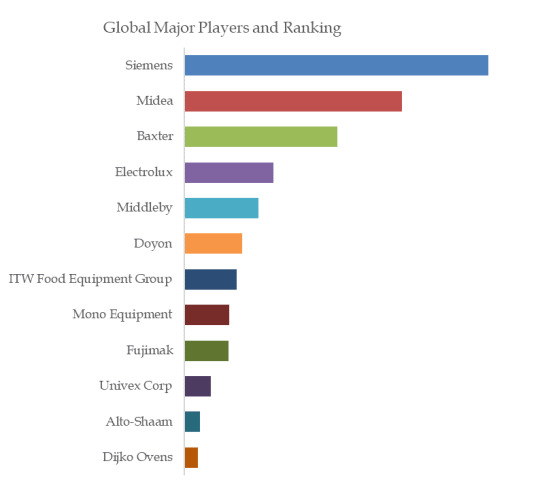
Above data is based on report from QYResearch: Global Commercial Cooking and Baking Equipment Market Report 2023-2029 (published in 2023). If you need the latest data, plaese contact QYResearch.
This report profiles key players of Commercial Cooking and Baking Equipment such as Siemens,Midea,Baxter,Electrolux,Middleby,Doyon,ITW Food Equipment Group,Mono Equipment,Fujimak,Univex Corp,Alto-Shaam,Dijko Ovens
In 2022, the global top five Commercial Cooking and Baking Equipment players account for 31.65% of market share in terms of revenue. Above figure shows the key players ranked by revenue in Commercial Cooking and Baking Equipment.
Figure. Commercial Cooking and Baking Equipment, Global Market Size, Split by Product Segment
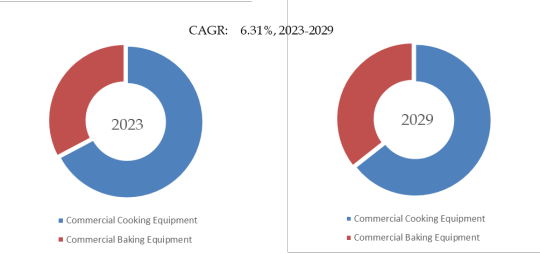
Based on or includes research from QYResearch: Global Commercial Cooking and Baking Equipment Market Report 2023-2029.
In terms of product type, Commercial Cooking Equipment is the largest segment, hold a share of 67.25%,
Market Drivers:
1. Technological innovation: Advanced technological innovation drives the development of commercial cooking and baking equipment, including more efficient heating technology, intelligent control systems, energy-saving technology, etc.
2. Growth in demand: As the catering, hotel and food service industries grow, the demand for efficient, large-capacity, multi-functional equipment has also increased accordingly.
3. Health and food safety awareness: Concerns about food health and safety have increased demand and driven innovation in equipment, such as food quality monitoring systems and equipment that meet hygiene standards.
4. Sustainability and environmental protection: Concerns about sustainability and environmental protection have prompted manufacturers to develop more energy-saving and environmentally friendly equipment to meet industry and consumer expectations.
5. Diverse menu needs: With the influence of globalization and multiculturalism, restaurants and hotels need more diverse cooking and baking equipment to meet the needs of different cuisines and menus.
Restraint:
1. High Cost: The use of advanced technology and high-quality materials makes commercial cooking and baking equipment more expensive, which may limit the purchasing power of small businesses or new entrepreneurs.
2. Complex maintenance: Some advanced equipment may require maintenance by professional technicians, which increases the cost of use and difficulty of maintenance.
3. Market saturation: Some equipment markets in the catering and hotel industry may be relatively saturated, and manufacturers need to find innovation points in the fierce competition.
4. Regulations and standards: Strict health, safety and environmental regulations may pose challenges to equipment design and manufacturing, requiring equipment manufacturers to continuously adjust to comply with regulations.
5. Technology Acceptance: Some chefs and business executives may be less receptive to new technologies, perhaps due to high training costs or distrust of new technologies.
About The Authors
Yaping Zhao - Lead Author
Email: [email protected]
About QYResearch
QYResearch founded in California, USA in 2007.It is a leading global market research and consulting company. With over 16 years’ experience and professional research team in various cities over the world QY Research focuses on management consulting, database and seminar services, IPO consulting, industry chain research and customized research to help our clients in providing non-linear revenue model and make them successful. We are globally recognized for our expansive portfolio of services, good corporate citizenship, and our strong commitment to sustainability. Up to now, we have cooperated with more than 60,000 clients across five continents. Let’s work closely with you and build a bold and better future.
QYResearch is a world-renowned large-scale consulting company. The industry covers various high-tech industry chain market segments, spanning the semiconductor industry chain (semiconductor equipment and parts, semiconductor materials, ICs, Foundry, packaging and testing, discrete devices, sensors, optoelectronic devices), photovoltaic industry chain (equipment, cells, modules, auxiliary material brackets, inverters, power station terminals), new energy automobile industry chain (batteries and materials, auto parts, batteries, motors, electronic control, automotive semiconductors, etc.), communication industry chain (communication system equipment, terminal equipment, electronic components, RF front-end, optical modules, 4G/5G/6G, broadband, IoT, digital economy, AI), advanced materials industry Chain (metal materials, polymer materials, ceramic materials, nano materials, etc.), machinery manufacturing industry chain (CNC machine tools, construction machinery, electrical machinery, 3C automation, industrial robots, lasers, industrial control, drones), food, beverages and pharmaceuticals, medical equipment, agriculture, etc.
0 notes
Link
Raising the Bar, Setting the Standard
Univex, a leading manufacturer based out of Salem, NH continues to bring innovation into the foodservice space. Check out their awesome line of food prep, pizza and bakery products. Proudly located in Salem NH, Univex is here to support your needs! Watch
0 notes
Text
Ruth Orkin, una nuova scoperta

Fino al 16 luglio le Sale Chiablese dei Musei Reali di Torino ospitano la grande mostra antologica su Ruth Orkin (Boston 1921 – New York 1985), fotoreporter, fotografa e regista statunitense, tra le più rilevanti del XX secolo. L’esposizione, curata da Anne Morin, organizzata da Chroma, prodotta dalla Società Ares srl con i Musei Reali e il patrocinio del Comune di Torino, vede 156 fotografie, la maggior parte originali, che ripercorrono la vita di una delle personalità più importanti della fotografia del XX secolo, in particolare tra il 1939 e la fine degli anni Sessanta, attraverso alcune opere come VE-Day, Jimmy racconta una storia, American Girl in Italy, uno dei suoi scatti più iconici, i ritratti di personalità quali Robert Capa, Albert Einstein, Marlon Brando, Orson Welles, Lauren Bacall, Vittorio De Sica, Woody Allen e altri. Affascinata dal cinema, Ruth Orkin sognava di diventare una regista, grazie anche all’influenza della madre, Mary Ruby, attrice di film muti, che la portò a frequentare le quinte della Hollywood degli anni Venti e Trenta del Novecento. Nella prima metà del secolo scorso, tuttavia, per una donna la strada per intraprendere questa carriera era disseminata di ostacoli, così Ruth dovette rinunciare al sogno di diventare cineasta e, quando le venne regalate la sua prima macchina fotografica, una Univex da 39 centesimi, si avvicinò alla fotografia, ma senza mai trascurare il fascino del cinema. Attraverso un’analisi molto specifica dell’opera di Orkin, la rassegna permette di capire i meccanismi messi in atto per evocare il fantasma del cinema nel suo lavoro, come nel suo primo Road Movie del 1939, quando attraversò in bicicletta gli Stati Uniti da Los Angeles a New York. In quell’occasione, Ruth Orkin tenne un reportage che raccontava questo viaggio e la cui linearità temporale si svolge in ordine cronologico. Ispirandosi ai taccuini e agli album in cui la madre documentava le riprese dei suoi film, l’artista inseriva l’immagine fotografica in una narrazione che riprendeva la progressione cinematografica, come se le fotografie fossero immagini fisse di un film mai girato. Il percorso propone inoltre lavori come I giocatori di carte o Jimmy racconta una storia, del 1947, in cui Ruth Orkin usa la macchina fotografica per fissare dei momenti, lasciando allo sguardo dello spettatore il compito di comporre la scena, ma anche le immagini del film Little fugitive (1953), candidato al Premio Oscar per la migliore storia cinematografica e vincitore del Leone d’argento alla Mostra del Cinema di Venezia, su un bambino di sette anni di nome Joey (Richie Andrusco) in fuga a Coney Island dopo essere stato indotto con l’inganno a credere di aver ucciso suo fratello maggiore Lennie, e che François Truffaut riteneva di fondamentale importanza per la nascita della Nouvelle vague. Nei primi anni Quaranta, Ruth Orkin si trasferì a New York, dove fu membro della Photo League, cooperativa di fotografi newyorkesi, ed ebbe prestigiose collaborazioni con importanti riviste, tanto da diventare una delle firme del momento. Con Dall’alto, lavoro di quegli anni, Orkin catturò perpendicolarmente da una finestra gli avvenimenti che si svolgono per strada, riprendendo alcune persone del tutto ignare di essere oggetto del suo sguardo, come un gruppo di signore che danno da mangiare ai gatti di strada; un padre che, acquistata una fetta di anguria, la porge alla figlia davanti al chiosco del venditore ambulante; due poliziotti che fanno cordone attorno a un materasso logoro abbandonato per strada; due bambine che giocano a farsi volteggiare l’un l’altra; un gruppo di marinai che incedono speditamente e che divengono riconoscibili per i loro cappelli che si stagliano come dischi bianchi sul fondale grigio dell’asfalto. La mostra racconta anche il reportage per la rivista Life, realizzato nel 1951 in Israele a seguito della Israeli Philarmonic Orchestra e del viaggio compiuto in Italia, visitando Venezia, Roma e Firenze, dove Ruth conobbe Nina Lee Craig, una studentessa americana, alla quale chiese di farle da modella per un servizio sull’esperienza di una donna che viaggia da sola in un paese straniero e che fu il soggetto di American Girl in Italy, una delle sue fotografie più iconiche. Read the full article
0 notes
Text
Technically, Color
So I finally got off my butt and decided to develop color film. The last time I did it, it half worked okay, and was half a disaster. This time... it was half okay and half a disaster. I don't know if I'll ever develop color at home again. I just kinda really hate it.
But I had an odd number of 135 rolls, and since my tank takes 2 rolls of 135 at once, I figured might as well thaw something to shoot.
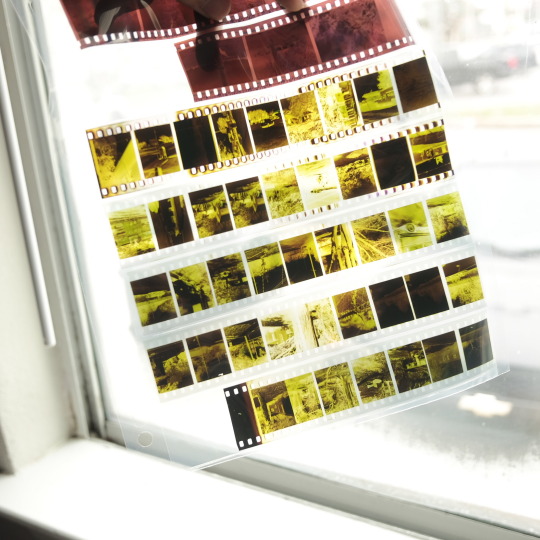
What is this? This is Kodak Vision3 2383. I can't find a lot of info on it, but apparently it was a duplicating film, and as a consequence of that, it is
super blue, (of course it's yellow, but converted, that's blue)
slow as a sloth on a holiday

Is it a color film? Looking at the pictures, I'd be tempted to say that it's not. Slam that saturation down, go with black and white. But wait... those tail lights.

Hmmm. A little better, but still not convincingly color.

Meh, probably as "color" as it gets.
Yeah, this film is WEIRD. I think since this was a duplicating film designed to counteract orange film bases, it makes sense that things are tinted super blue.

I think there's a cinema film that's also labeled Kodak 2383 that's like a fully chromatic cinema film, and then there's the duplicating stuff. But again, very little documentation on either.
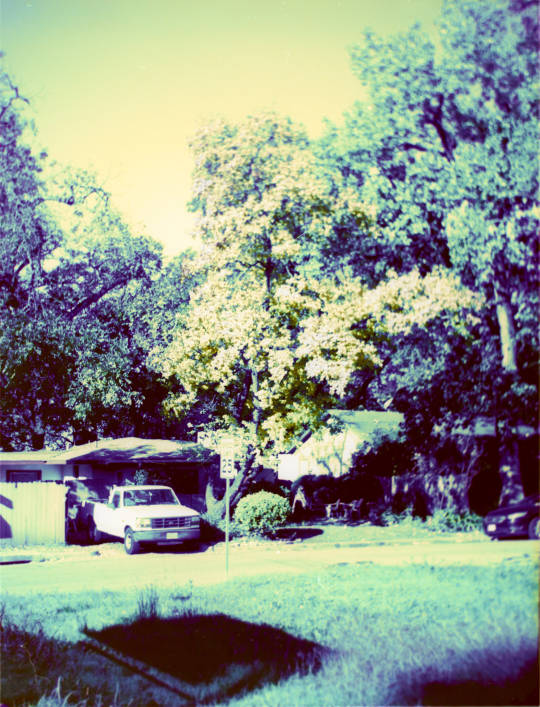
Oh look a bit of "green"(?) in the tree. I also struggled a lot to color balance the shots since there's no way to index it on what the scene is... supposed... to look like, and the film base washed out clear, so I couldn't even use that as a white point.

But what about the other thing I mentioned? Its slowness? Is it iso 100? iso 50? iso 12?

Try 3. Yup. iso 3.

Since my only 35mm camera on hand was the Mercury II (half-frame by Univex), I shot wide open at f/2.7 all the time, and adjusted my shutter speed between 1/30th to 1/60th, most of the time staying at 1/40. Just barely hand-holdable.
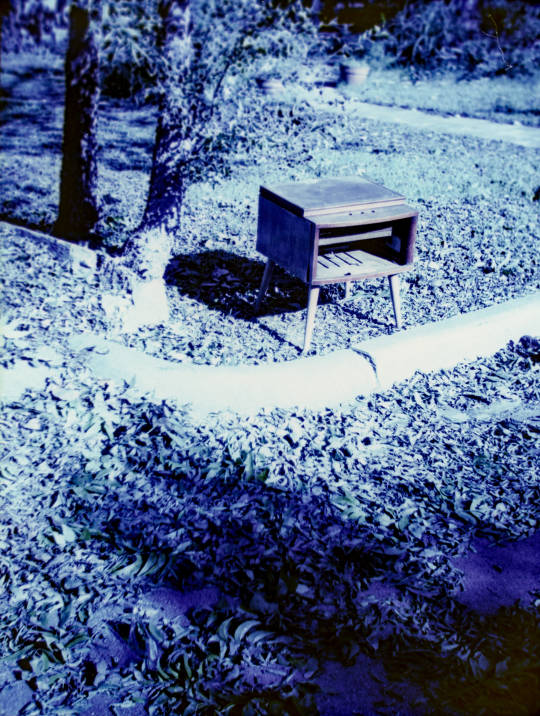
Look at these shots though! There's still so little grain for being half-frame shots.
Anyway, those are all my shots. Would I shoot this again? Ehhhhhh no. The results are too experimental for me, and honestly, I don't mind some film grain all that much. I'm glad I had this experience though. Super weird film.
#kodak#kodakfilm#analog photography#analog#kodak vision 3#homedevelopment#homedevelopedfilm#mercuryii#univex mercury#univex#staybrokeshootfilm#filmsnotdead
3 notes
·
View notes
Photo

Appareil photo Univex Bakelite Model AF4 Camera 1935 - source Art Deco.
27 notes
·
View notes
Photo

Berlinde De Bruyckere
Vanwege een tere huid, 2015 (II), 2015, watercolor and pencil on paper, collage, 45 x 29 cm
32 notes
·
View notes
Photo

Revere 8mm, Univex C8 8mm, Bell & Howell Filmo 8mm, Bell &Howell Perpetua Drive Super 8, Kodak Brownie Turret 8mm, Keystone Capri K24, Bell & Howell 172 8mm, Keystone K-717A #bellhowell #kodak #revere #keystone #Univex #filmo #brownie #super8 #vintagecamera #photo #raleigh #vintage8mm #8mm #photography #camera #film #filmisnotdead #filmcameras #filmcamerasinternational #filmshooters #filmlovers #staybrokeshootfilm #filmisnotdead #letsshoot #analogue #filmisalive #lomo #streetfeet #filmisalive #l0m0graphy #dowhatyoulove (at Raleigh, North Carolina)
#staybrokeshootfilm#kodak#filmcameras#super8#photography#photo#raleigh#analogue#dowhatyoulove#bellhowell#univex#filmisalive#filmcamerasinternational#camera#revere#l0m0graphy#letsshoot#filmlovers#vintagecamera#film#8mm#streetfeet#brownie#filmisnotdead#filmshooters#lomo#keystone#filmo#vintage8mm
1 note
·
View note
Photo



Univex AF
Universal Camera Corp., ca. 1935
George Eastman Museum
54 notes
·
View notes
